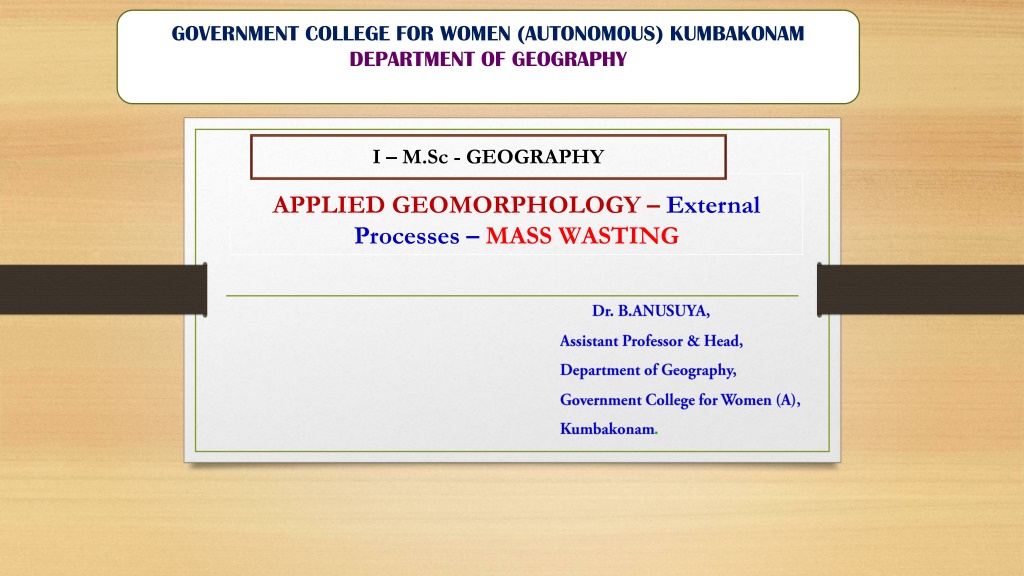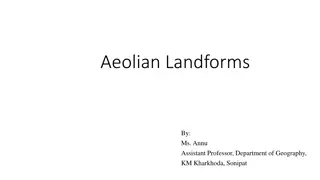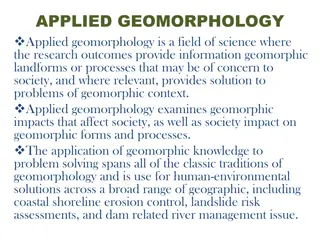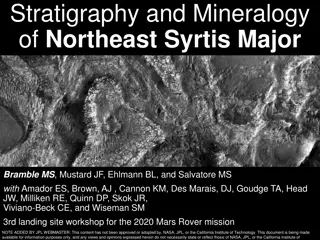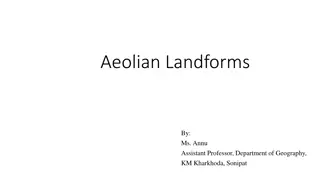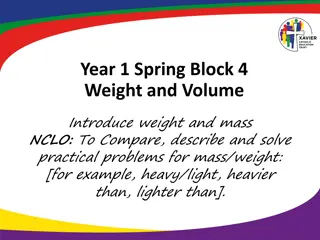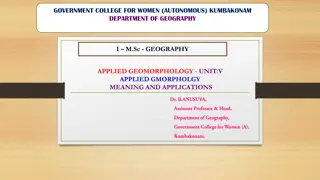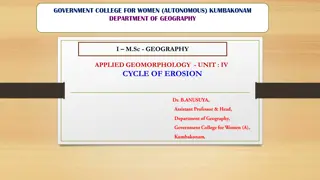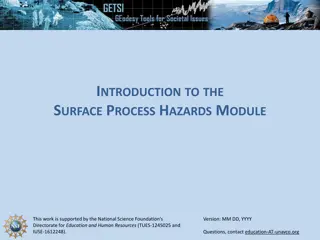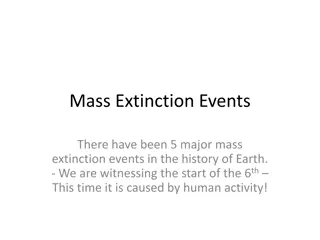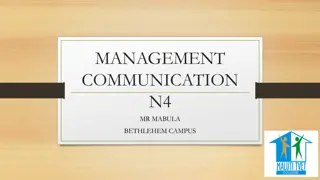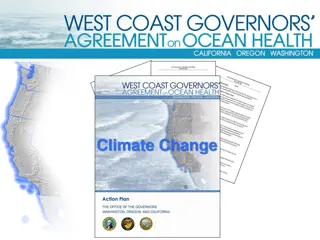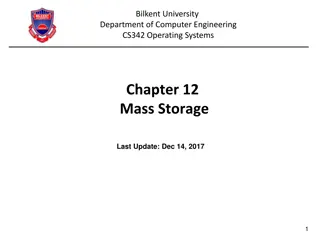Understanding Mass Wasting: Geomorphic Processes and Causes
Mass wasting, a geomorphic process driven by gravity, involves the movement of soil, rocks, and debris downslope. Landslides are common triggers, caused by factors like erosion and gravitational pull. Different types of mass movements, from gradual creep to rapid landslides, shape the Earth's surface over varying timescales.
Download Presentation

Please find below an Image/Link to download the presentation.
The content on the website is provided AS IS for your information and personal use only. It may not be sold, licensed, or shared on other websites without obtaining consent from the author. Download presentation by click this link. If you encounter any issues during the download, it is possible that the publisher has removed the file from their server.
E N D
Presentation Transcript
GOVERNMENT COLLEGE FOR WOMEN (AUTONOMOUS) KUMBAKONAM DEPARTMENT OF GEOGRAPHY I M.Sc - GEOGRAPHY APPLIED GEOMORPHOLOGY External Processes MASS WASTING
UNIT: II UNIT: II APPLIED GEOMORPHOLOGY APPLIED GEOMORPHOLOGY External Processes External Processes - -MASS WASTING Definition of MASS WASTING: Mass wasting can be defined as a geomorphic process. A geomorphic process is a natural course of weathering, erosion and deposition that causes alteration of the surface materials and landforms of the earth. Mass wasting is also known as slope movement or mass movement. Mass wasting, also known as slope movement or mass movement, is the geomorphic process by which soil, sand, regolith, and rock move downslope typically as a solid, continuous or discontinuous mass, largely under the force of gravity, frequently with characteristics of a flow as in debris flows and mudflows. MASS WASTING
Which causes movement in mass wasting? Landslides are the most common causes of mass wasting. They result in the movement of earth, rock, and debris downhill. Landslides can be massive, small, high speed, or slow. Water, wind, and earth tremors can result in landslides that lead to mass wasting. What are the factors involved in mass wasting? It exposes soil to erosion leaving it without protection against the force of raindrops, which moves loose rocks and soil. However, the most important factor to initiate mass movement is the gravitational pull of the earth. Different types of mass wasting or mass movement can be identified.
Mass-wasting definition is - the process involving movement of mantlerock that is controlled directly by gravity and that includes such gradual movements as creep and solifluction and such rapid movements as produce rockfalls, landslides, and mudflows. Mass wasting is the downhill movement of mud, rocks, or debris. Mass wasting, sometimes known as slope or mass movement, is the large movement of soil, rock, and debris downhill because of the force of gravity. It is a natural phenomenon initiated by gravity but made possible by a combination of several factors. Mass wasting, also known as slope movement or mass movement, is the geomorphic process by which soil, sand, regolith, and rock move downslope under the force of gravity. Types of mass wasting include creep, slides, flows, topples, and falls, each with its own characteristic features, and taking place over timescales from seconds to years.
Mass Wasting If a rock slides off of a mountain and no one is around to hear it, does it make a sound? Well, I don't know about the noise this activity would create, but I do know that mountains erode and that rocks and debris can slide and fall down mountain slopes in massive amounts. In this lesson, you will learn about a process called mass wasting and the factors that cause this movement of material. Mass wasting, which is sometimes called mass movement or slope movement, is defined as the large movement of rock, soil and debris downward due to the force of gravity. In other words, the earth's outer crust is being 'wasted' away on a 'massive' scale and falling to lower elevations.
Mass wasting is a type of erosion, and it is capable of making big changes to the side of a mountain. These changes can happen suddenly, as in one minute the rock is there and the next it is gone, or it can happen more slowly over time. You might think of this process as a landslide, and this term is sometimes used interchangeably with mass wasting. However, the term landslide is a bit limiting and does not allow for a description of the many different triggers and types of erosion that can happen on this large of a scale. Causes of Mass Wasting Now, we mentioned that mass wasting is mainly due to gravity. So, we see that mountains have an ongoing tug-of-war with gravity. Gravity is constantly trying to pull rock and debris down the slope of a mountain. At the same time, the resistive forces of the mountain, including the cohesive strength and internal friction between the materials, referred to as the mountain's shear strength, constantly pulls back against gravity. The shear strength works to maintain the slope's stability and keep the materials in place. This is a lot like a mountain climber gripping onto the side of a mountain and resisting gravity. The climber uses his grip strength to resist gravity, like the mountain uses its shear strength.
With this understanding, we see that the causes of mass wasting occur when gravitational force overcomes the resistive forces of the mountain. And, since gravitational pull is always constant, then we see that mass wasting occurs when something changes the mountain's ability to resist gravity. For instance, an increased slope steepness increases mass wasting simply because the gravitational force acting on a steep slope is greater than the force acting on a gentle slope. Increasing the steepness of a slope is one way man can increase mass wasting. For example, if a road crew cuts away a slope to make room for a new road but makes the angle of the slope too steep, the slope will be prone to mass wasting, and you will want to cross your fingers when you drive past this steep slope so no rocks or debris fall on your car!
Increased water is another factor that plays an important role in mass wasting. Water can wash away small particles that help keep the mountainside intact. This is similar to what happens when a wave comes ashore and washes away a sandcastle. The abundant water breaks apart the small sand particles and destroys the structural stability of the castle you spent the afternoon building. If an area has decreased vegetation, it will be more prone to mass wasting. Vegetation stabilizes soil particles on the surface and anchors soil under the surface through its root system. This is much like comparing two sand dunes on a beach. If one sand dune has grasses growing on it, it will resist the erosion of water and wind better than a sand dune without vegetation. Another factor that plays a role in mass wasting is earthquakes. The violent shaking that occurs in a region where an earthquake takes place has the ability to break off sections of mountains or hills, causing them to slide down the slope.
Slumps and Rockslides Because there are different factors that cause mass wasting, not all wasting happens in the same way. In some cases, we may see a large portion of the slope fail and slide or roll downhill. In other cases, large collections of debris may flow, like a river, down the side of a mountain mixed with water or air. One of the types of mass wasting that is an example of the slope failing is a slump. This is the sliding of coherent rock material along a curved surface. It's almost as if the section of the mountain or hillside slumps its shoulders and shrinks in height. This is easy to image happening if you consider that a slump often results due to an undercutting of the mountain's base. For example, water might erode the base of a cliff. Without the base, the outer sections of the mountain slumps down as a unit or multiple units.
CAUSES OF MASS WASTING: Volcanic activity. Volcanic eruptions many times causes huge mudflows. The snow cover of a volcano melts in the heat and mixes with the soil to form ... Landslides. Mudslide. Weathering and erosion. Ice wedging. Which causes movement in mass wasting? Landslides are the most common causes of mass wasting. They result in the movement of earth, rock, and debris downhill. Landslides can be massive, small, high speed, or slow. Water, wind, and earth tremors can result in landslides that lead to mass wasting.
Mass wasting, sometimes called mass movement, is the downward movement by gravity of rock, regolith (loose, weathered rock) and/or soil on the sloped top layers of the Earth s surface. It is a significant part of the process of erosion because it moves material from high elevations to lower elevations. It can be triggered by natural events like earthquakes, volcanic eruptions and flooding, but gravity is its driving force. Although gravity is the driving force of mass wasting, it is impacted mainly by the slope material s strength and cohesiveness as well as the amount of friction acting on the material. If friction, cohesion, and strength (collectively known as the resisting forces) are high in a given area, mass wasting is less likely to occur because the gravitational force does not exceed the resisting force.
The angle of repose also plays a role in whether a slope will fail or not. This is the maximum angle at which loose material becomes stable, usually 25 -40 , and is caused by a balance between gravity and the resisting force. If, for example, a slope is extremely steep and the gravitational force is greater than that of the resisting force, the angle of repose has not been met and the slope is likely to fail. The point at which mass movement does occur is called the shear-failure point. Types of Mass Movement There are several kinds of mass movement namely: Soil flows Mudflows Soil creep Landslides Rock falls
Soil flows- soil flow happens when the soil receives heavy amount of rainfall turning the soil into semi liquid state. During this process, the liquid state of the soil allows it to flow downwards as soil or mud flow. However, the materials slump making step- like terraces and leaving actuate scarps at their heads and an accumulation bulge at the toe. When slopes are steeper, even the bedrock especially of soft sedimentary rocks like shale or deeply weathered igneous rock may slide downslope. Mudflows In the absence of vegetation cover and with heavy rainfall, thick layers of weathered materials get saturated with water and either slowly or rapidly flow down along definite channels. It looks like a stream of mud within a valley. When the mudflows comes out of channels onto the piedmont or plains, they can be very destructive engulfing roads, bridges and houses. Mudflows occur frequently on the slopes of erupting or recently erupted volcanoes. Volcanic ash, dust and other fragments turn into mud due to heavy rains and flow down as tongues or streams of mud causing great destruction to human habitations. This can may also occur due to volcanic activity. Mudflows are common in tropical regions where there is deep weathering of soils and abundant rainfall.
Soil creeps. Soil creep refers to the slow downward movement of weathered materials or soil materials down a gentle slope. The most powerful force is water which now acts as the main trigger which enables the rock materials to roll or creep over others. The factors that can encourage soil creep are heating and cooling, wetting and drying of the soil in alteration. Landslides landslide takes place when large quantities of loosened surface rocksand soil suddenly slide down a steep slope such as a cliff face, a valley side or an embankment. Landslides are cause by the lubricating action of water and the pull of gravity. This type of mass wasting is most rapid of all and very destructive. Slides occur as planar failures along discontinuities like bedding planes that dip steeply. The actions that help to produce a landslide are the undercutting of the base of a steep slope by a river or sea and by human action. Landslide are often triggered off by an earthquake or by prolonged erosion.
The materials involved are relatively dry. The size and shape of the separated mass depends on the nature of discontinuities in the rock, the degree of weathering and the steepness of the slope. Several types of landslides are identified depending on the movement of material involved. slum- slipping of one or several mass of rock debris with a backward rotation with respect to the slope over which the movement takes place. Debris slide- rapid rolling or sliding of earth debris without backward rotation of mass, this is nearly a free fall of earth debris from vertical or overhanging face. Rockfalls These are referred to a mass of rock which fall from a steep cliff; they involve the sliding of individual rock masses down bedding, joint or fault surfaces. Rockfalls occur from the superficial layers of the rock face, an occurrence that differentiates it from rockslide which affects materials up to a substantial depth. When this happens over a steep slopes, it is very fast and destructive, and when the sequences continue for over a long period of time, the broken rocks collect at the base of the slope in a mound.
Debris Avalanche these are turbulent clouds of debris mixed with air that rush down steep slopes in this case, they move relatively slowly. This type of mass movement is more common in the humid regions, it can take place with or without vegetation cover and occurs in narrow tracks on steep slopes. This debris avalanche can be much faster than the mudflow. Debris avalanche is similar to snow avalanche. Causes of mass movement The removal of support from below to materials above through natural or artificial means Increase in gradient and height of slopes- height of slopes increase mass movement. When the slope is overly steep, gravity will pull the material downward, causing a mass movement. The angle of repose can also influence how fast the material will move, if a slope is extremely steep and the gravitational force is greater than that of the resisting force, the angle of repose has not been met and the slope is likely to fail. Weathering- chemical weathering produces weaker minerals while physical weathering breaks rocks apart.
Overloading due to heavy rainfall, saturation and lubrication of slope material- An overabundance of water allows the soil to be very mobile. Water actually lubricates the soil and contributes to additional weight, thus too much of it reduces cohesion. Excessive natural seepage earthquakes or explosions Earthquakes, explosions and machinery are also common causes of mass movement. As the ground shakes, due to the energy released during the earthquake or explosion, portions of the hillside or mountain can loosen up and slide down slope. Heavy drawdown of water from lakes, reservoirs and rivers leading to slow outflow of water from under the slopes or river banks- excess water can wash away small particles soil that help keep the hillsides intact. Indiscriminate removal of natural vegetation or scarcity of vegetation- an area with very scanty vegetation is also prone to mass movement, this is because vegetation helps to hold the soil in place, which prevents it from washing down the hillside. When vegetation is removed, that anchor is lost and soil can be easily roll away. Overloading through addition of materials naturally or by artificial filling
Effects of mass movement Once a very large portion of soil is removed, it is very hard for it to be replaced and regain back it nutrients. Landslides can be a more severe cause of the soil erosion problem. After a heavy downpour, the entire hillsides saturated with water can slide downward, causing serious structural damage to buildings, homes, and agricultural land use. Mudflow and debris falls can damage human settlements that are located at the foot of the mountains, this may also affect the transport systems on the lower slope regions.
Types of Mass Wasting Once the force of gravity on a mass of rock or soil reaches the shear-failure point, it can fall, slide, flow or creep down a slope. These are the four types of mass wasting and are determined by the speed of the material s movement downslope as well as the amount of moisture found in the material. Falls and Avalanches The first type of mass wasting is a rockfall or avalanche. A rockfall is a large amount of rock that falls independently from a slope or cliff and forms an irregular pile of rock, called a talus slope, at the base of the slope. Rockfalls are fast moving, dry types of mass movements. An avalanche, also called a debris avalanche, is a mass of falling rock, but also includes soil and other debris. Like a rockfall, an avalanche moves quickly but because of the presence of soil and debris, they are sometimes moister than a rockfall. Landslides Landslides are another type of mass wasting. They are sudden, fast movements of a cohesive mass of soil, rock or regolith. Landslides occur in two types- the first of which is a translational slide. These involve movement along a flat surface parallel to the angle of the slope in a stepped-liked pattern, with no rotation. The second type of landslide is called a rotational slide and is the movement of surface material along a concave surface. Both types of landslides can be moist, but they are not normally saturated with water.
Flow Flows, like rockfalls and landslides, are fast-moving types of mass wasting. They are different however because the material within them is normally saturated with moisture. Mudflows, for example, are a type of flow that can occur quickly after heavy precipitation saturates a surface. Earthflows are another type of flow that occur in this category, but unlike mudflows, they are not usually saturated with moisture and move somewhat slower. Creep The final and slowest moving type of mass wasting is called soil creep. These are gradual but persistent movements of dry surface soil. In this type of movement, soil particles are lifted and moved by cycles of moistness and dryness, temperature variations and grazing livestock. Freeze and thaw cycles in soil moisture also contribute to creep through frost heaving. When soil moisture freezes, it causes soil particles to expand out. When it melts though, the soil particles move back down vertically, causing the slope to become unstable.
Types of Mass Wasting A rock fall are the fastest of all landslide types and occurs when a rock falls through the air until it comes to rest on the ground not too complicated. In Utah, they are common in the spring and fall because of freeze-thaw weathering. In the daytime, temperatures in the spring and fall tend to be above freezing, which allows liquid water to enter cracks within rocks. At night, the temperatures cool below freezing and the water within the rocks freezes and expands which causes the rock to break more. The following morning, the ice will melt and go deeper within the crack to refreeze later that night. This freeze-thaw action over time can cause rocks to break off and fall to the ground. The debris the accumulates at the base of these steep slopes is called talus. But rock falls can also occur when heavy precipitation is falling on a steep slope, causing the rocks to lose friction and fall. The YouTube video below is a rock fall captured in Taiwan in late August 2013, following heavy precipitation in the region .
. Rotational slides occur when the a landslide occurs in a curved manner concave to the sky. When this type of slide occurs, the upper surface of the slide tilts backwards toward the original slope and the lower surface moves away from the slope. They are common when the soil tends to be deep in clay or soft sediment deposits. The video on the right is a large landslide again in Taiwan in early September 2013 following every rainfall. Needless to say, they were having a bad few days in the region. Transitional Slides Rather than rotating, a translational slide occurs when slope failure occurs parallel to the slope. Often times the slope failure occurs on soil composed of clay or shale, or along old fault lines, or previous slide areas. What makes translational slides dangerous is that they tend to flow faster and travel farther than rotational slides.
Debris flows are one of the most common, but most dangerous of the various types of landslides because of their speed and consistency. Debris flows tend to be a mixture of rock and water with two to three times the density of flooding streams. That density allows debris flows strip away the land and pick up objects as large as school buses. Debris flows are most common at the mouth of canyons along alluvial fans. Lets first explain an alluvial fan. When floods occur within the mouth of a canyon, either because of intense thunderstorms or snow melt, the erosive power of the water can pick up sediment and boulders a debris flow. Now once the debris flow reaches the mouth of a canyon, the sediment gets deposited in a fan-shaped delta called an alluvial fan. The problem is that people like to live along alluvial fans because of their scenic view on the canyon. Another influence of debris flows is wildfires. When a wildfire strips an area of its vegetation, the bare soil is easily eroded away in either a thunderstorm or snow melt creating these debris flows. Because of Utah s topography and tendency to wildfires, debris flows are quite common.
VOLCANIC MASS WASTING: Lahars were mentioned in the module on volcanoes, but in essence they are volcanic landslides. Recall that volcanoes eject pyroclastic material ranging is size from ash to boulders. Now there tends to be two ways lahars occur. One is if a thunderstorm precipitates large amounts of moisture on the pyroclastic material and the pyroclastics flow down slope. The other option is if a volcano is snow-capped and the heat from the volcano causes some of the snow to melt and mix with the pyroclastic material. What makes lahars so dangerous is that they have the consistency of concrete and can travel hundreds of miles.
What is mass wasting and how does it affect the Earth? Although mass wasting results in shaping the earth but also effects vegetation, humans and other species. It has caused many destruction to buildings, vegetation, humans and animals. Mass wasting produces different landforms on the earth not only on land but also in sub-marine slopes. How do mass movements affect the environment? Abstract. Mass movements affect the following elements of the environment: (1) the topography of the earth's surface, particularly the morphologies of mountain and valley systems, both on the continents and on the ocean floors; (2) the character/quality of rivers and streams and groundwater flow;
Effects of mass movement Once a very large portion of soil is removed, it is very hard for it to be replaced and regain back it nutrients. Landslides can be a more severe cause of the soil erosion problem. After a heavy downpour, the entire hillsides... Mudflow and debris falls can damage human settlements that are located at the foot of the mountains, this may also
